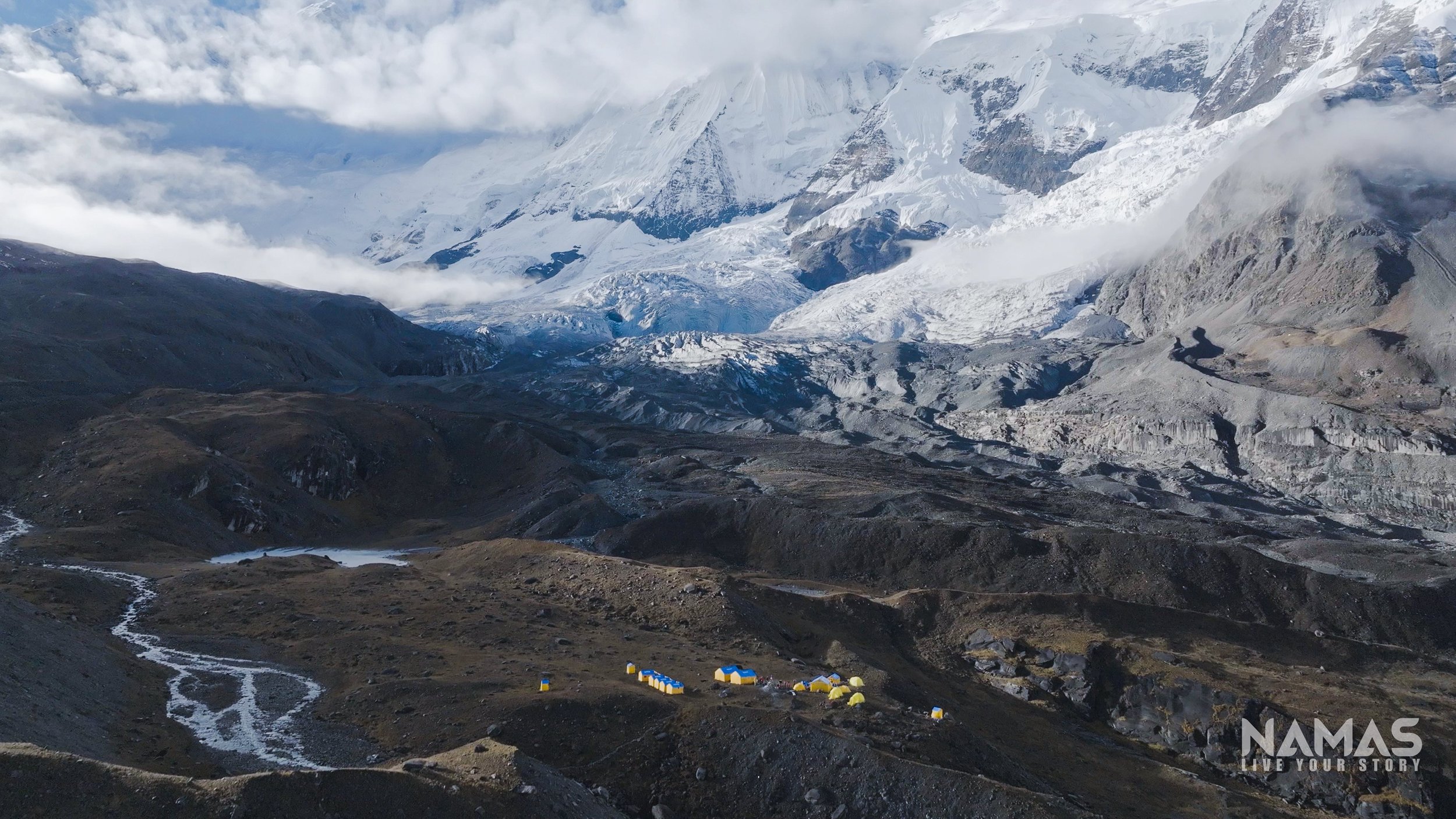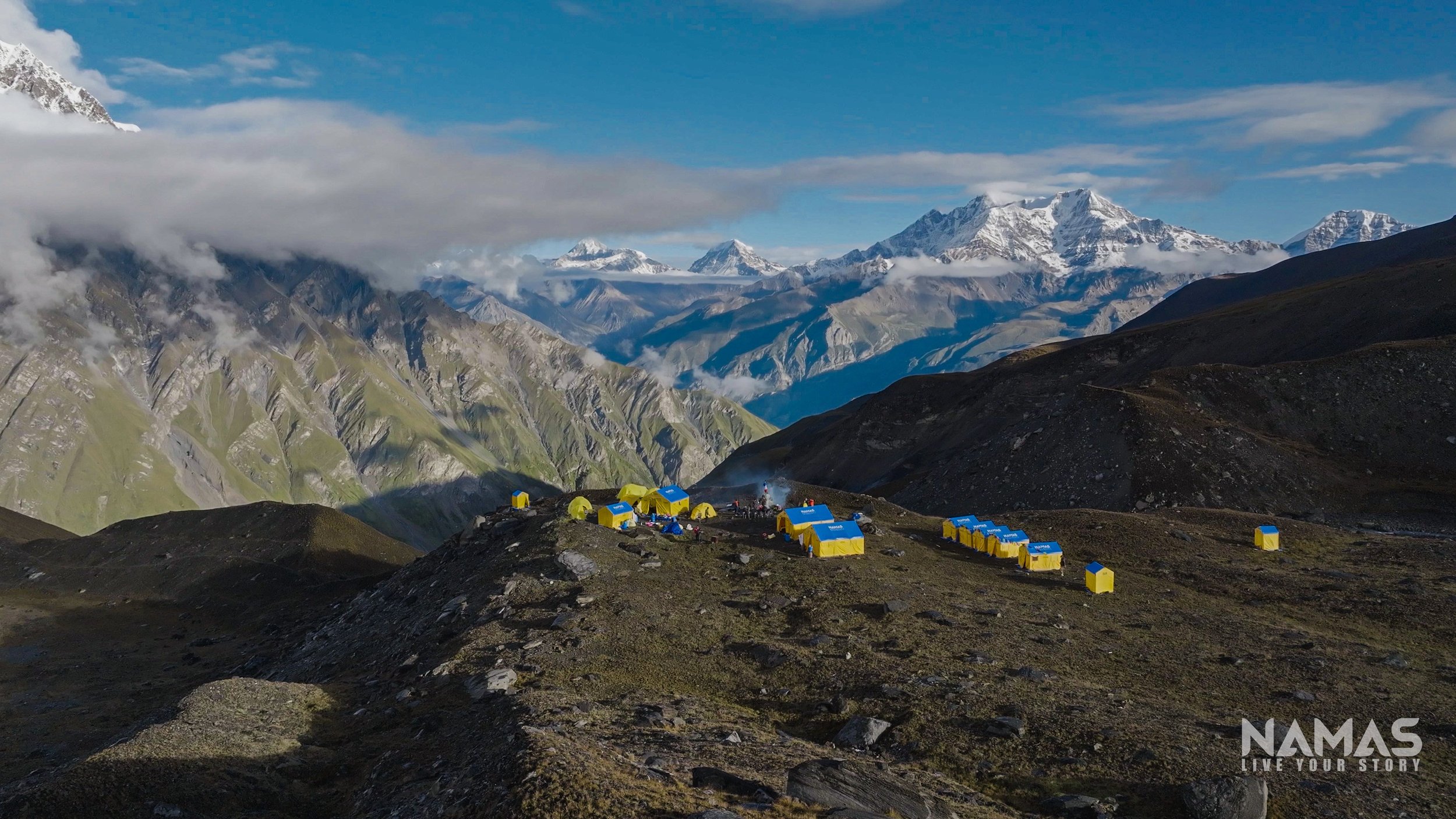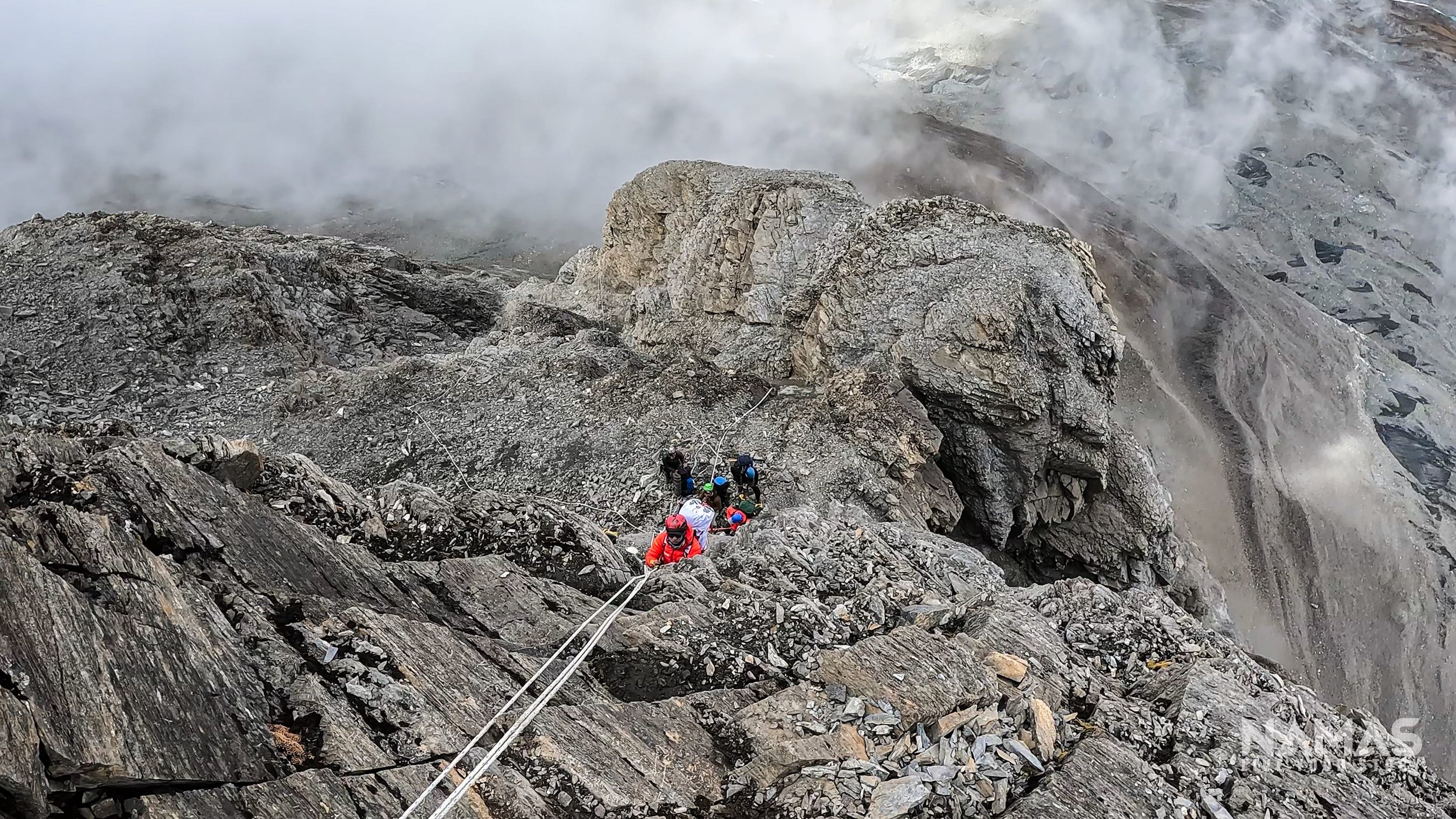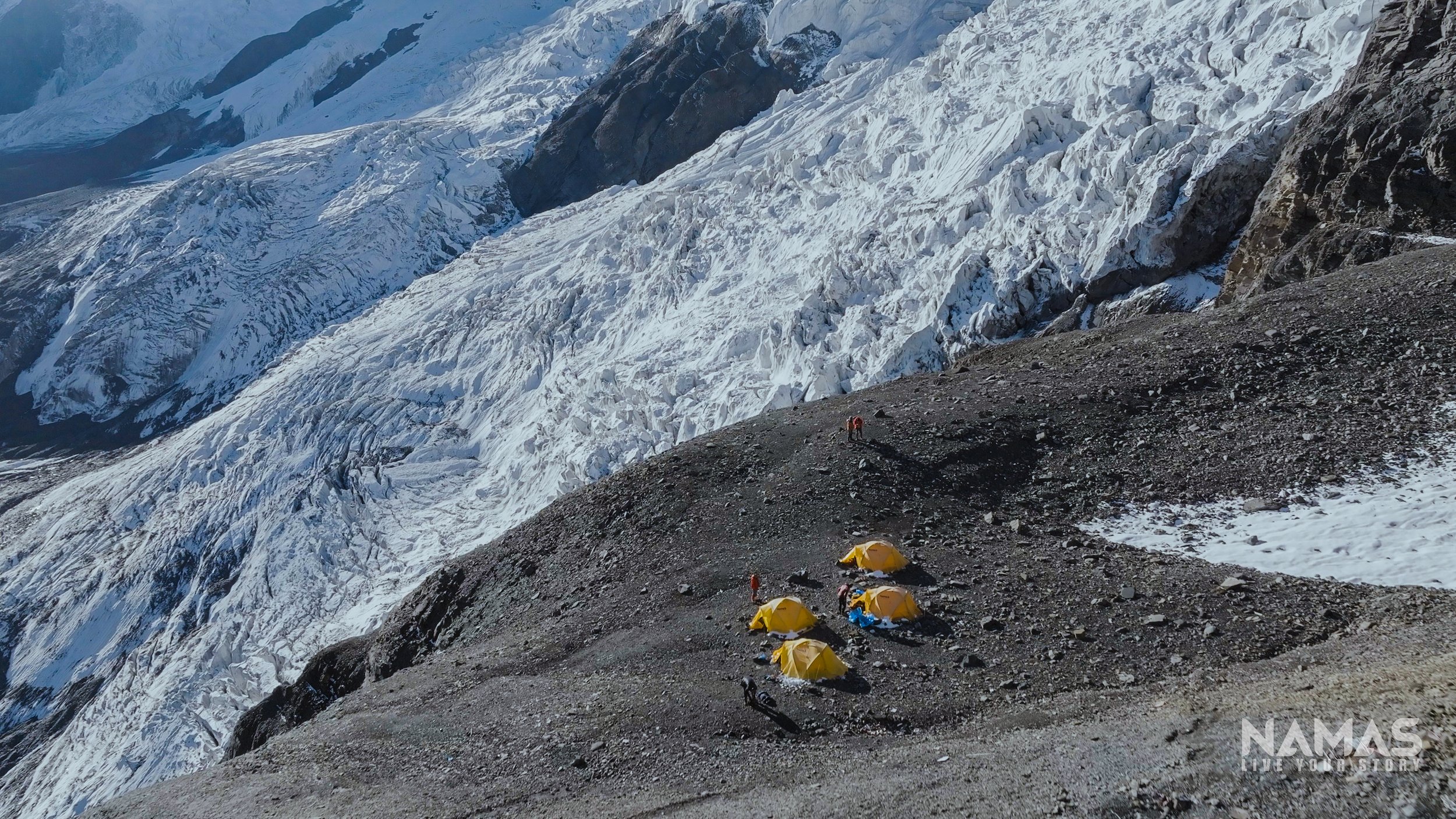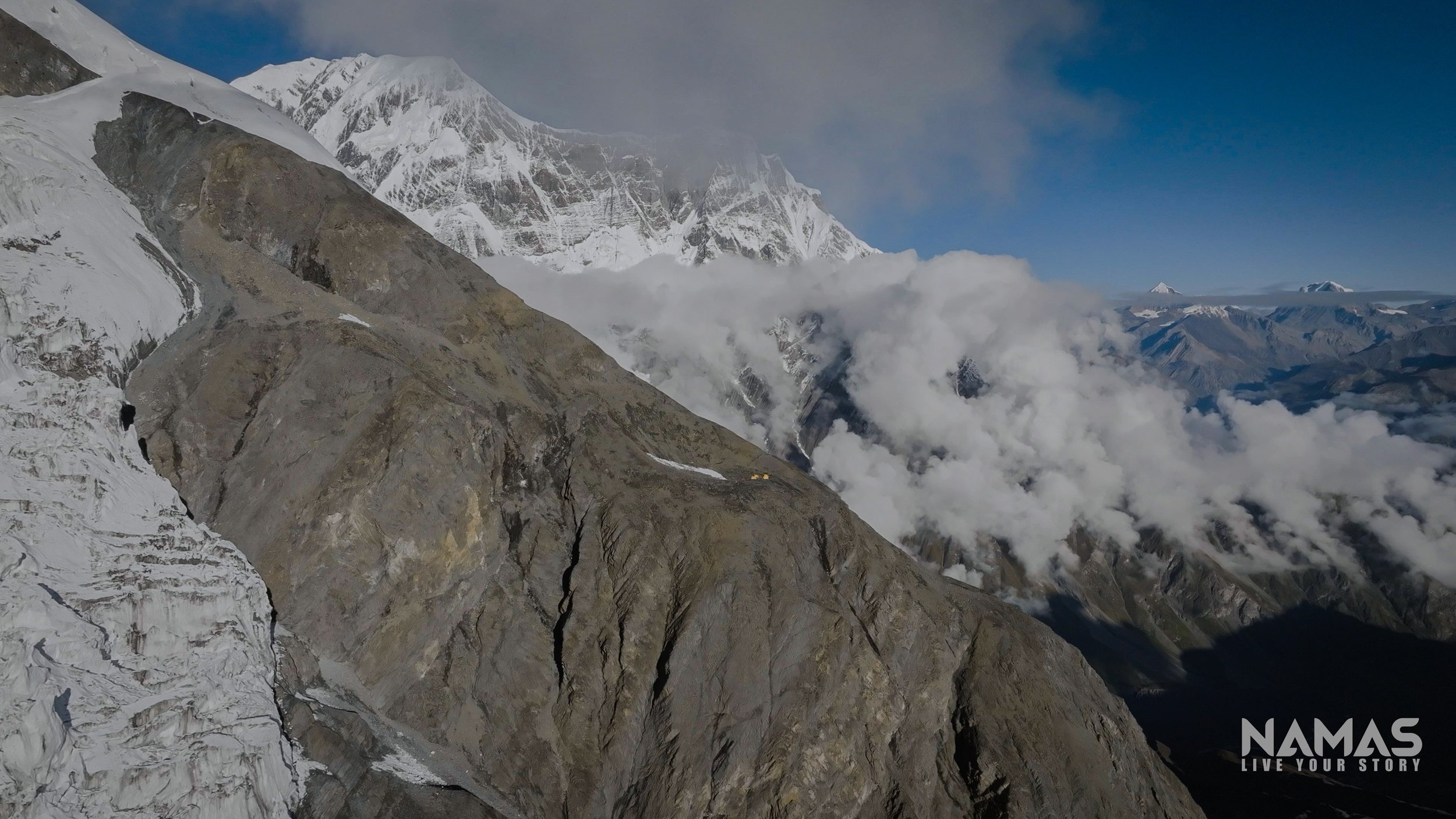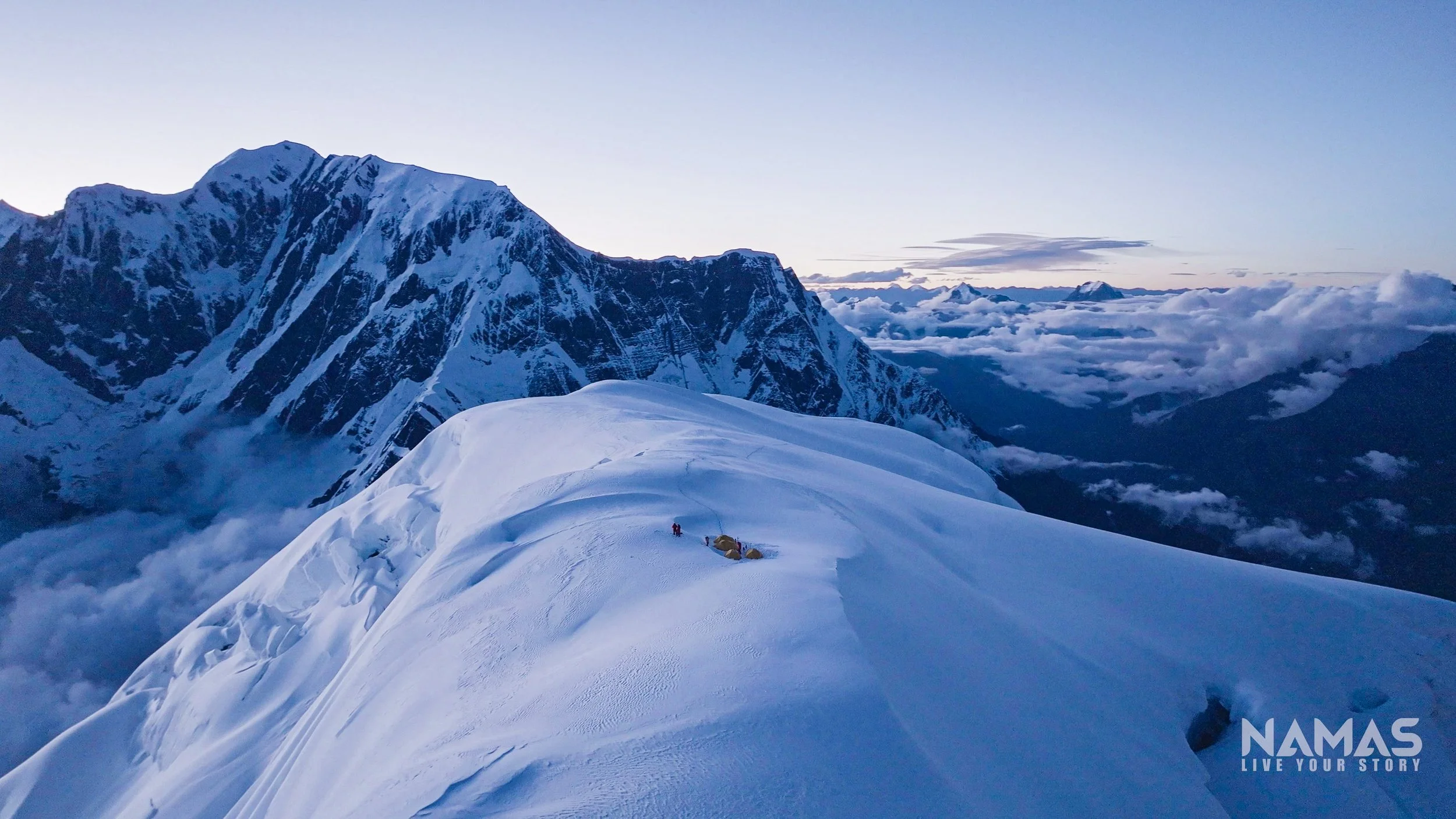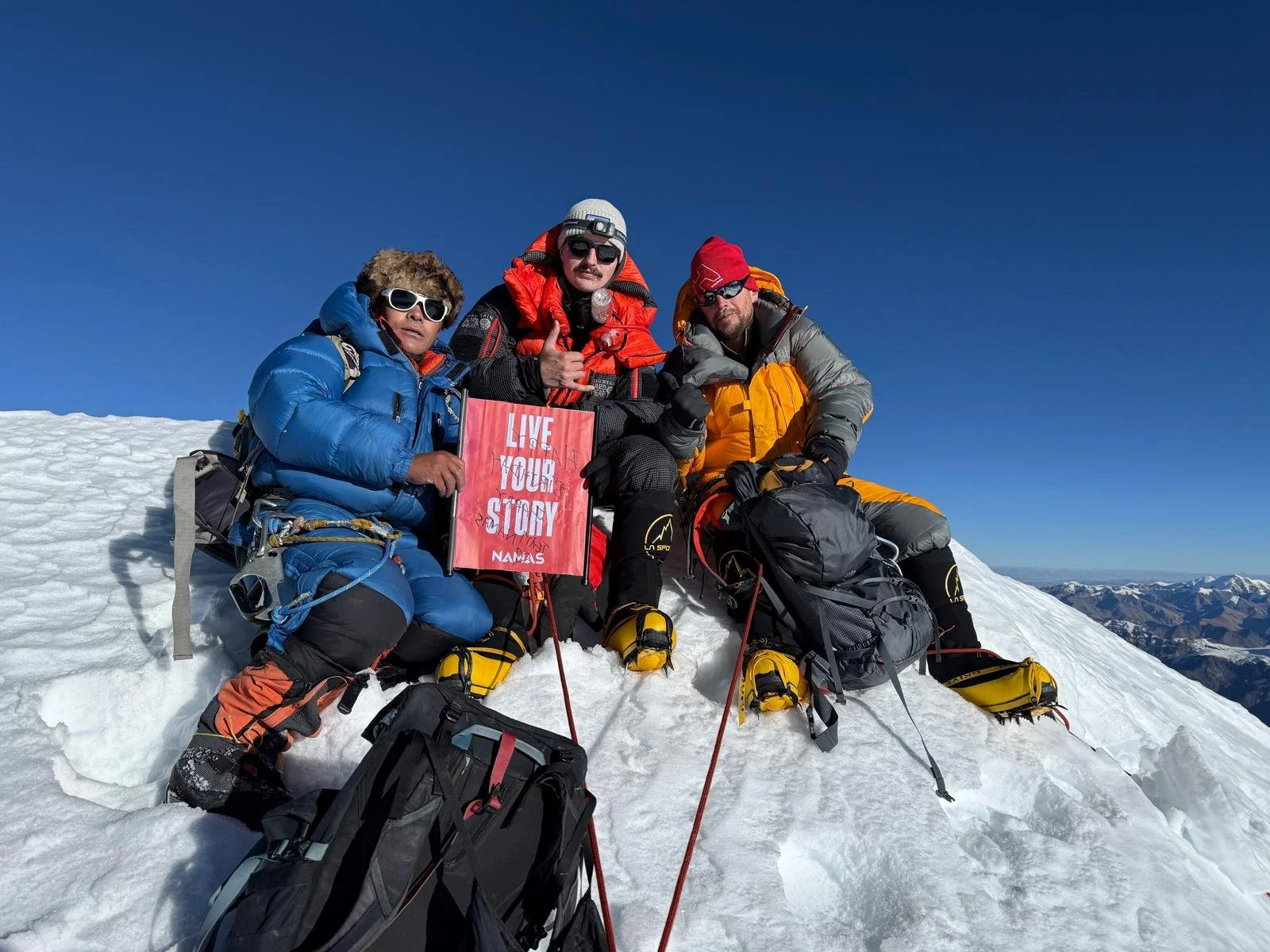
ANNAPURNA IV 7525M : Preprations for tougher 8000er
HIGHLIGHTS
NAMAS Adventure was the first team to SUMMIT (2023) and conduct a successful expedition at Annapurna IV after 2010.
2023, 2025 Expedition - 100% SUMMIT & SAFETY
Rarely climbed 7500M Peak with few objective dangers. Just Namas team during autumn departures
1:1 Sherpa guide support. Small team strategy. 3-12 max client members
16 Weeks of training programs for 7000M from Training Peaks
Personal supplemental oxygen (1 cylinder and regulator)
Skip entry level 8000M and get ready for Everest or another 8,000m peaks
Camp 1, 2 & 3 strategy. Heated Dining tent, solo tent at base camp
OVERVIEW
Annapurna IV 7525M is the perfect mountaineering objective for climbers who wants the thrill of climbing at extreme altitude with fewer crowds and relatively less technical difficulty compared to other peaks in the Annapurna massif. Annapurna IV is part of the great Annapurna massif range, standing tall between Annapurna II 7937M/26040FT on the western side and Annapurna III 7555M/24787FT to the eastern face. The climbing route has fewer objective dangers and is relatively a semi-technical climb. To clear out the confusion amongst the Annapurna massif range (Annapurna I, II, III, IV, and Gangapurna) IV is the least dangerous and least technical. This mountain is not climbed as often as other peaks in the region.
Pre-requisite requirements (two or more): Lobuche East & Island Peak, Chulu West, Khumbu 3 Peak expeditions, Aconcagua (Similar semi-technical 6000M peaks or higher), Denali, Himlung Himal 7126M or higher.
There is no question about the beauty and challenges of climbing this 7525M+ giant but this expedition is by no means a walk in the park. Graded at TD+/4 the climbing route consists of some technical climbs as well as glacier routes, rocky vertical climbs, and steep exposed ridges. This mountain will shape you with the right experience to climb 8000M peaks or even Mt. Everest.
-
2023 Autumn season. Namas Adventure team was the only team to summit this year. 3 out of 4 client members summited Annapurna IV.
4th Member reached upto 7300M+ and had to return due to incoming bad weather and white out situation at 7300M elevation.
2025 Autumn season. 100% Safety and Summit, 2x Male & 2x Female. 1 member without supplemental oxygen. 2 members with supplemental oxygen. 1 member summit without and descend with supplemental oxygen.
-
Spring 2026
27th April - 26th May
Autumn 2026
5th October - 1st November - Signature Climb (Max 3 members)
3rd October - 1st November (limited spots remaining) - Classic climb
16th October - 1st November (15 Days express - only 3 spots)
Spring 2027
30th April - 25th May - Signature Climb (Max 3 members)
27th April - 25th May (limited spots remaining) - Classic climb
Autumn 2027
3rd - 30th October - Signature Climb (Max 3 members)
1st - 30th October (Max 8 members) - Classic climb
15th - 30th October - 15 Days express climb - (Only 2 spots)
-
USD 21,500 - Signature Climb
USD 12,950 P/P - Classic Climb
Deposit required: USD 1,500 P/P
All-inclusive. Guaranteed departure. No extra hidden costs.
Please inquire about prices in your local currency. We accept payment in £GBP/ €EUROS/ $AUD
-
IFMGA or NMA certified Guide leader
Namas Branded merchandise (Down Jacket, Cap, Buff)
1:1 Sherpa guide/client ratio. (Additional Sherpa Guide can be arranged, extra charges apply)
16 Weeks of training programs for 7000M from Training Peaks
Head chef and 2 kitchen helpers ( Helpers increase with the number of climbing team members )
1X Personal Oxygen cylinder and regulator
2 nights before the expedition and 1 day after the expedition. 5 Star hotel. Single-room hotel in Kathmandu. (Should clients return early from their expedition, clients will be responsible for their extra Kathmandu hotel bookings)
2 Nights luxury stay in Nagarkot. 90 min Massage session, breath-work session, foot massage reflexology & facial, after expedition. (Sauna included)
1 Night at Pokhara hotel
All trekking and climbing permits
All internal-local transportation to and from the trekking trailhead
Solo tent at BC, and 2 person tent at higher camps
40 kgs personal weight
Meals during camping days (Chicken, mushroom, vegan options, etc)
Burners and expedition equipment
Walkie-talkie/ Satellite phone
Breakfast, Lunch, and Dinner on trek and expedition days.
Lodge accommodation during the trek
Arrival pick-up and departure
Internal flights
Basic First aid kit
Welcome or Farewell leave Dinner
-
IFMGA or NMA certified Guide leader
Namas Branded merchandise (Down Jacket, Cap, Buff)
1:1 Sherpa guide/client ratio. (Additional Sherpa Guide can be arranged, extra charges apply)
16 Weeks of training programs for 7000M fromTraining Peaks
Head chef and 2 kitchen helpers ( Helpers increase with the number of climbing team members )
1X Personal Oxygen cylinder and regulator
2 nights before the expedition and 1 day after the expedition. Single-room hotel in Kathmandu. (Should clients return early from their expedition, clients will be responsible for their extra Kathmandu hotel bookings)
1 Night at Pokhara hotel
All trekking and climbing permits
All internal-local transportation to and from the trekking trailhead
Solo tent at BC, and 2 person tent at higher camps
40 kgs personal weight (Extra additional weight, clients will need to hire an additional porter. Estimated $1000 USD for 27-28 days)
Meals during camping days (Chicken, mushroom, vegan options, etc)
Burners and expedition equipment
Walkie-talkie/ Satellite phone
Breakfast, Lunch, and Dinner on trek and expedition days.
Lodge accommodation during the trek
Arrival pick-up and departure
Internal flights
Basic First aid kit
Welcome or Farewell leave Dinner
-
Visas and travel insurance
Summit Bonus ($1000 per member)
Entertainment and food (Kathmandu & Pokhara)
Bottled drinks and beverages
Evacuation (will be done in your account)
Single supplement Charges for private setup arrangements
Laundry, Phone services, Personal expenditure transactions
Optional trips
Tea breaks, chocolates or other snacks, and any meals besides breakfast, lunch, and dinner.
Delay and cancellation because of natural phenomenon
International flights to Kathmandu
-
138 Summits
-
Quote: USD 25,000 P/P
Duration: 15 Days (Heli In/Out)
For more informations please email us - bookings@namasadventure.com
-
Shuhan 🇨🇳 - Annapurna IV 7525M (2025 Fall)
⭐️⭐️⭐️⭐️⭐️
It took me over a month to finally sit down and write the review, as I’ve been reflecting on the reason I was drawn to Annapurna IV in the first place. The more I climbed, the more I realized what truly matters to me in any expedition — not just altitude or adrenaline, but the sense of exploration and adventure, both outwardly and inwardly. It’s about raw, intact nature, vast landscapes, and the rare chance to explore less “popular” peaks with a small group of people who genuinely adore the mountains.
NAMAS is really unique in this regard, as they are probably the only operator I’ve come across with that true explorer mindset, organizing expeditions on rarely-climbed 7,000-meter peaks, running small teams, trailblazing rather than following others’ steps, and having a team of Sherpas who are highly competent, caring, and really know what they are doing when it comes to the mountains they operate on — which makes all the difference when you venture onto peaks like Annapurna IV.
I’ve always been less interested in chasing summits for sheer numbers. What I value is the solitude, the ability to fully enjoy the experience, and hopefully to climb in slightly better style every single time. Annapurna IV, which is a technically demanding, rarely-climbed 7,500-meter peak, seemed to perfectly fit that profile, being challenging but not overcrowded, offering stunning views, where I could try pushing my limits a little bit further without supplemental oxygen.
If your ideal expedition is similar (to climb with purpose, explore places very few people have been to, and share good vibes with like-minded people who respect the mountains and local culture), Annapurna IV is definitely worth considering, and NAMAS is absolutely the team to go with.
Of course, I cannot leave the review without mentioning the impressive setup at base camp, the delicious food thanks to the effort of the kitchen crew (I will come back for more scrambled eggs and momos!), the kindness and professionalism of our climbing Sherpas, and the extremely well-organised logistics. I had the pleasure of meeting Bisesh in person in London to discuss my experiences, so didn’t have much exchange with Sushmita prior to booking, but trust me, if here is anything you are unsure about, she is the best and most responsive!
Simply a 10/10 experience with amazing people. Thank you NAMAS team for making it happen!Yi Schuler 🇺🇸🇨🇳 - Annapurna IV 7525M (2025 Fall)
⭐️⭐️⭐️⭐️⭐️
I climbed Annapurna IV with NAMAS Adventure in Oct of 202. From the time I made my first inquiry in April, I knew I’d be in good hands. Sushimita was prompt, thorough and professional in her responses to my endless questions. My request to have a video call with the trip manager Bisesh who is also the founder of NAMAS was quickly accommodated. Here are a few highlights that show how attentive to details the NAMAS team are:
1. Airport pickup and drop off: nicely arranged, clearly communicated to us ahead of time. Family also received detailed contact info in case of emergency.
2. Hotel stays before and after the climb in Kathmandu: beautiful, safe and conveniently located posh hotels with western amenities and thoughtful cultural touches all included in our trip costs.
3. Cultural excursions: thoughtful arrangements of a visit to Pokhara in the company of a sherpa we climbed with. It eases the logistical hassles we had to deal with so we can focus on enjoyment and exploration.
4. Tea houses: every tea house we stayed at has established relationships with NAMAS. We were welcome in the kitchens and treated like family.
5. Basecamp: I was pleasantly surprised by the comfort and accessibility of the basecamp: each of us had our own personal tent to rest, a shower/bath tent, a toilet tent, dining/community tent, kitchen tent, supply tent… starlink access, snacks and great food choices from print menus.
6. Training plans: our acclimatization and rotation days were thoughtfully planned and implemented to ensure our summit success.
7. Sherpas and other support staff: our Sherpas (1:1ratio) are very knowledgeable and experienced with the Himalayan mountains, including Sherpas who have summited Everest 24 times. They are strong, fun, meticulous, caring and professional too. We were able to achieve 100% summit success largely because of their expertise and dedication.
8. On this climb, NAMAS helped us four climbers achieve a few firsts: first American woman, first ethnic Chinese, first Australian… to summit this beast.
If you are looking for a Himalayan guiding company who knows how to do things right and who is willing to partner with you to accomplish your mountain goals, look no further than NAMAS. I’m surely happy I found them for my first Himalayan climb. Can’t wait to climb with NAMAS again.Dr. Ronald Pieters 🇬🇧 🇳🇱 (2023 Annapurna IV)
⭐️⭐️⭐️⭐️⭐️
Another great expedition! This was my third time with Namas and it exceeded expectations.
The kindness, skill, and unity of the Namas team was palpable all the time. They again proved to be super-efficient, resourceful, always with a smile, and radiating great team spirit. The sherpas were outstanding. Kind and helpful, with great skill and insight and a good sense of humor. A lot of them knew each other, it had a family feel to it.
Paljor who helped me last year on Himlung Himal is such a great chap. Rental gear was good, a warm comfy Kailash sleeping bag, Black Diamond crampons, and Harness and helmet. Basecamp set up was excellent and well organised. A nice roomy tent for each and a great communal-dining tent in stunning location.
We pushed up high quite fast because of a short favourable weather window and finished the expedition a week ahead of schedule! A tough but very interesting mountain. Recommended. I especially got to appreciate and love ‘the wall’, between basecamp and camp 1.
It was great to have Bisesh as a team member! Looking forward to my next expedition with Namas.
ITINERARY - signature climb
Day 1-2 Arrive in Kathmandu, Transfer to Hotel for expedition briefing.
Day 3 🚁 Heli from Kathmandu to Humde
Day 4 Humde to Base camp 4850M
Day 5 - 23 Climbing Period for Annapurna IV Summit (7,525M) (19 Days of climbing, Base Camp. Puja ritual ceremony, contingency day, Training, and preparation for a summit bid. We will aim 1 rotations between Camp 1 & 4)
Day 24 -25 🚁 Base Camp - Humde - Kathmandu (may include Shuttle flights). Drive to Nagarkot - NAMAS Signature Reset & Recover
Day 26 Kathmandu
Day 27 Departure
ACCOMMODATIONS
Day 1 - 2 and 23 (Hotel)
Day 21 - 22 Luxury stay at Nagarkot
Day 5 - 20 (Alpine Camping)
-
Day 1-2 Arrive in Kathmandu, Transfer to Hotel for expedition briefing.
Day 3 Drive Kathmandu to Besi Sahar (8 hours)
Day 4 Drive to Manang 3500M (7 hours)
Day 5 Manang acclimatisation and evening hike to Humde
Day 6 Humde to Base camp 4850M
Day 7 - 25 Climbing Period for Annapurna IV Summit (7,525M) (19 Days of climbing, Base Camp. Puja ritual ceremony, contingency day, Training, and preparation for a summit bid. We will aim 1 rotations between Camp 1 & 4)
Day 26 Base Camp to Humde
Day 27 Humde to Pokhara
Day 28 Pokhara rest day
Day 29 Sunrise in Pokhara and flight to Kathmandu
Day 30 Departure
ACCOMMODATIONS
Day 1 - 2 and 31 - 32 (Hotel)
Day 8 - 28 (Alpine Camping)
-
Day 24 — Physical Reset & Nervous-System Downshift
Arrival - Silent check-in & welcome ritual (no briefings, no schedules)
Deep tissue / sports recovery massage (60–90 mins) - Focus: calves, quads, hips, lower back, shoulders
Infrared or traditional sauna session
Guided breath work session (20–30 mins) - Helps shift from survival mode to recovery mode
Day 25 — Mental Closure & Gentle Reawakening
Slow wake-up with sunrise Himalayan views
Guided mindfulness or reflection session → closing the climb mentally, not just physically
Foot therapy / reflexology and Facial
Guided breath-work session (20–30 mins) - Helps shift from survival mode to recovery mode
-
🚁 Helicopter charter Kathmandu to Humde - USD 4500
🚁 Helicopter BC to Kathmandu - USD 5500
Annapurna IV + Chulu Far East - USD 17,300 Per Person
Annapurna IV + Ama Dablam - USD 23,000 Per Person
-
138 Summits
Annapurna IV vs. Manaslu: Which is Better for Everest Preparation?
The Strategic Comparison: Manaslu (8,163m) is the 8th highest mountain in the world. It looks like the “bigger” step on paper. But if your goal is to perform on Everest—not just qualify—Annapurna IV (7,525m) is often the smarter training ground. Here’s why:
Technical Challenge: Annapurna IV is raw, exposed, and skill-demanding. Manaslu’s standard route has become heavily commercialized and, in many seasons, feels like an altitude conveyor belt. Annapurna IV forces sustained steep climbing, clean movement on fixed lines, and disciplined rope systems—exactly the kind of competence that transfers to the Lhotse Face.
Remote Environment: Manaslu has become crowded and noisy—base camp can feel like a small city. Annapurna IV gives you the “true expedition” environment: fewer teams, fewer shortcuts, and more responsibility. You learn to manage logistics, pace, and decision-making in a smaller unit—building the mental resilience and self-reliance required for a long Everest campaign.
Altitude Efficiency: Yes, Annapurna IV is ~600m lower. That’s the point. You spend less time buying altitude and more time earning it through technical output. It still satisfies the 2026 Nepal Everest qualification requirement, but it also protects you from the biggest trap in modern climbing: “checking the box” and arriving on Everest under-skilled for the Death Zone.
HOW DOES IT WORK?
1. Initial Inquiry and Planning
At NAMAS Adventure, we start by understanding your aspirations and goals. From your first conversation with our expert team, we provide personalized recommendation tailored to your interests. Once the perfect expedition is identified, a deposit secures your spot. We then work closely with you to plan and prepare every detail—from gear selection and training advice to arranging insurance, permits, and logistics.
2. Preparing for the Journey
As your expedition date approaches, we’ll help you finalize all preparations. This includes collecting the final balance payment (typically due 60-90 days before your trip), ensuring all necessary documents are in order, and addressing any remaining questions. Our team is available via email or phone calls to make sure you’re fully prepared and confident for the adventure ahead.
3. On-Expedition Support
Arrive at your destination ready to begin! From pre-expedition briefings and gear checks to the full support of our experienced guides and ground team during your climb, we’re here to ensure everything runs smoothly. With flexibility to adapt to any changes or needs, we’re committed to making your adventure seamless, enjoyable, and unforgettable

Annapurna IV Expedition FAQs
About the Mountain
-
Annapurna 4 is part of the grander Annapurna massif range in central Nepal. It sits right between Annapurna 2 and 3 and can be considered the safest Annapurna climb.
-
Spring (Mid March – May) is ideal, is considered the best time to climb overall in Nepal. This period generally provides clear skies, stable weather and great snow conditions in the mountain. We must say Annapurna 4 has been least climbed or explored during the spring season.
Autumn (Late September - November) is another great climbing window in overall Nepal and in the Annapurna region. We have operated mostly during the autumn season at Annapurna 4 achieving summit and safety success in our expeditions.
-
For the Annapurna IV expedition, our team takes on the classic North-West Ridge route, known for its stunning views and fewer objective risks compared to other 7000M peaks. Our experienced rope-fixing team sets up fixed lines all the way to the summit, making the climb safer and more manageable, even on the steeper, more exposed sections.
Our strategy is straightforward but flexible. We typically establish three camps—Camp 1, Camp 2, and Camp 3—along the North-West Ridge to support a gradual, well-paced ascent. A potential Camp 4 may be set up, but our expedition leader will make that call based on real-time mountain conditions to ensure safety and success. For a deeper dive into our climbing plan, check out the Expedition Strategy section on our Annapurna IV page
-
Annapurna IV is considered an advanced 7000m expedition and is graded TD+ (Technical Difficile Plus), alpine grade 4. It’s a serious climb ideal for mountaineers preparing for 8000m expeditions.
The route includes steep snow slopes, vertical sections, exposed ridges, and mixed rock-ice terrain. Fixed lines are placed on technical sections, but climbers must be proficient in:
Rock and mixed climbing
Climbing in deep snow and cold conditions
Rappelling and ascending fixed lines efficiently
Traversing exposed, technical alpine terrain
This is not a “guided walk-up.” Annapurna IV demands solid alpine experience, strong physical fitness, and mental resilience in high-altitude conditions.
-
Summit day on Annapurna IV is a straightforward but demanding high-altitude climb, primarily on ice and snow terrain. We start the ascent early in the morning (typically 1:00–3:00 AM) to ensure safe snow conditions and favorable weather.
The route from High Camp (Camp 3) involves:
Moderate to steep snow slopes
Fixed ropes on steeper sections
Cold, windy conditions — proper layering and focus are critical
Depending on team pace and conditions, we aim to reach the summit by mid-morning, then descend safely back to Camp 3 or Camp 2 for rest.
While the route isn’t highly technical on summit day, it requires strong endurance, solid crampon technique, and the ability to move efficiently in extreme conditions.
-
Our team maintains a high success rate due to strong logistics, expert Sherpas, and smart acclimatization plans.
We have 100% safety record at Annapurna 4 (Touch wood)
-
Yes — significantly safer.
Annapurna IV is widely regarded as the safest and most achievable expedition in the Annapurna massif.
Annapurna I (8,091m) is one of the most dangerous 8000ers, with a high fatality rate due to avalanches and unstable terrain.
Annapurna II & III are extremely technical and exposed, rarely attempted by commercial expeditions due to objective hazards and low success rates.
Annapurna IV offers a more stable, predictable route with fewer fatal incidents, strong summit history, and proven safety under expert management.
It’s still an advanced climb, but with proper acclimatization, technical readiness, and our experienced support team, Annapurna IV offers a safe and smart pathway into high-altitude Himalayan climbing.
-
Climbing Annapurna IV (7525M) is a serious but achievable challenge for intermediate mountaineers. You’ll need to be comfortable using crampons, ascending with a jumar, and descending with a 10–15kg pack. The North-West Ridge route includes steep, rocky sections (especially between Camps 1, 2, and 3) and some exposed ridges, requiring fixed-rope climbing skills typical of Himalayan expeditions. It’s rated TD+/4, making it tougher than entry-level 7000M peaks like Spantik but safer than 8000M giants like Annapurna I.
We set up 3–4 camps, with Camp 4 depending on mountain conditions, as decided by our expedition leader. Our Sherpa team fixes ropes to the summit (weather permitting), and you’ll use supplemental oxygen from the final camp to boost safety and success. With fewer climbers on Annapurna IV, expect a hands-on experience with stunning views.
-
Many climbers choose Annapurna IV over Manaslu because it is less crowded and more technically demanding. While Manaslu offers 8000m altitude exposure, the terrain, remoteness, and climbing style on Annapurna IV often provide a more realistic simulation of the summit push section and the level of self-reliance required on Everest, making it a strong training peak for serious Everest aspirants.
Experiences - preprations - team
-
If you’ve successfully climbed several 4000M–6000M peaks and are preparing for an 8000M objective like Everest, Annapurna IV is an ideal next step. It offers a true high-altitude climbing experience without the crowds—comparable to Manaslu in challenge—and now fulfills Nepal’s new 7000M summit requirement to qualify for Everest.
-
You’ll need prior high-altitude climbing experience, ideally on 6000M peaks like Khumbu 3 peak or Annapurna 3 peak, or combo exped like Lobuche East (6119M), Island Peak (6189M), or Alpamayo (5947M). Familiarity with rock climbing, glacier travel, fixed-rope climbing, and basic ice/snow techniques (e.g., using crampons and ice axes) is essential. Our 16-week Training Peaks program will help you build the stamina and skills needed, but you should already have some alpine climbing under your belt.
-
This is a serious 7000M climb, so you need to be in top physical shape. Expect long days (8–12 hours) at high altitude with a 10–15kg pack. Focus on endurance (e.g., 5–6 hour hikes), strength training (e.g., squats, deadlifts), and high-intensity intervals (e.g., VO2 max sessions). We recommend a hypoxic tent for acclimatization training. Our team provides a personalized training plan when you book, tailored to your current fitness level.
-
Yes, Annapurna IV involves moderate technical climbing (TD+/4 grade), including rock climbing, glacier routes and steep snow/ice ridges (up to 50°). You should be comfortable with fixed ropes, jumaring, and basic ice climbing. If you’ve climbed 6000M peaks in Nepal and other technical peaks around the world, you’re on the right track. Our IFMGA/NNMGA-certified guides will lead the way and provide refresher training at base camp.
4000 - 6500 M peak of mountain summit. Your adaptability to high altitude and climbing on high steep terrains.
Rock climbing grade 5.7 - 5.9
Commitment to regular endurance and strengthening training.
Climbing with crampons on and understand the nature of physical demands that the mountain requires.
Ascending with jumar and descending on fixed rope
-
Once you book with us we provide a 16 week training program from Training Peak.Begin training at least 16 weeks before departure. Key areas include:
• Cardio: Run, cycle, or hike 4–5 times weekly to build endurance.
• Strength: Focus on legs, core, and upper body with exercises like lunges and pull-ups.
• Altitude Preparation: Practice hikes at elevation or use a hypoxic tent.
• Technical Skills: Brush up on rope work,
-
On this expedition we aim to have max 10 climbers, we have 1 Main guide who will be IMFGA or NMA certified. He will be the main leader of the team. We believe that Nepalese certified guides are more than capable in this day and age and have an excellent level of English. We are committed to responsible tourism and want to enhance and prioritise local Nepalese leaders first, but if the clients request a western guide personally then we can have that arranged.
Sherpa ratio 1:1. Our Sherpas are NMA (Khumbu climbing centre trained/certified). Additional Personal Sherpa for 1:1 can be arranged who will be solely responsible for the clients but extra additional charges apply. Our Sherpas have an intermediate level of English. Can understand, reply and instruct very well.
-
Suggested Additional Summit tips $1000.
-
No — you don’t. One of the unique aspects of climbing in Nepal is the high level of support. Our Sherpa team handles all logistics at high camps, including:
Setting up tents
Melting snow for water
Preparing basic meals
This allows you to focus fully on the climb, rest, and recovery.
Please note that at high altitudes, meals and water service are basic and may take time due to conditions — your patience is appreciated.
Annapurna IV Expedition
Planning Annapurna IV expedition? Namas Adventure is here at your service. We are now offering a climb to this remote and rarely climbed amazing peak in the Annapurna massif. The climbing experience will help you upskill and take on Mt. Everest without the need to climb other entry-level 8000M mountain peaks. This expedition will run for 32 days.
Inquire, learn and book your Annapurna IV expedition online with us. We also offer you the opportunity to shorten your trip and return directly from Humde to Kathmandu by helicopter charter for an additional price. You don’t need to worry about hidden expenses with us and any additional cost will be explained by our team.
Your safety is a prime concern for us. We give the utmost importance to this aspect more than anything else. You can find a well-thought-out expedition strategy with Namas Adventure. There is no guesswork and our experience as an adventure tour service provider goes beyond 30 years. We have the expertise and experience to plan and design outstanding expedition packages to make your expedition safe and successful.
Our Annapurna IV expedition tour itinerary follows a clear and transparent method of approach. We provide the necessary gear and equipment to make climbing safe and exciting.

